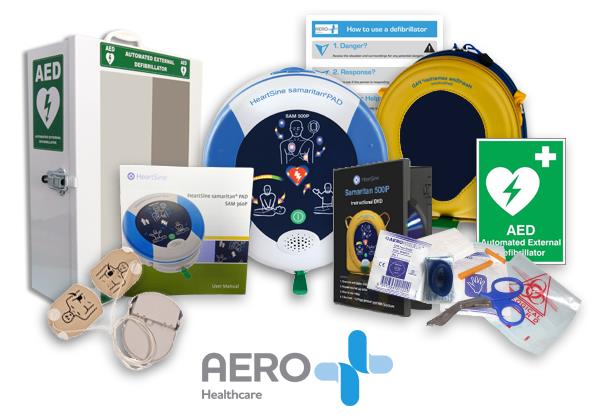This National Heart Month, we’re highlighting how vital AEDs are in workplace, the legal requirements for employers and how and when you’d need to use one.
If someone collapses to the floor and is unresponsive and not breathing, their heart has stopped working (they are in cardiac arrest) and time is critical.
Quick use of an Automated External Defibrillator (AED) can lead to survival rates of 50% to 70%* and if someone is unresponsive and not breathing, every minute that passes without chest compressions and defibrillation reduces their chance of survival by up to 10%*.
What is an AED?
An AED, or Automated External Defibrillator, is used to help someone who is in cardiac arrest (unresponsive and not breathing). It's a sophisticated yet easy-to-use medical device that, through pads applied to the chest, can analyse the heart's rhythm and, if necessary, deliver an electrical shock to the heart.
Legal requirements in the workplace
The Health and Safety (First-Aid) Regulations 1981 require employers to provide “adequate and appropriate” equipment, facilities and personnel to ensure that employees receive immediate attention “in the event of injury or sudden illness at work”.
The decision whether an employer needs to provide an AED, and train their staff how to use it, would be completely dependent on the outcome of the first aid needs assessment.
While there is no specific legal requirement for employers to provide AEDs in the workplace, in many modern working environments, AEDs are often being added to a company’s first aid provision on site.
Where an employer has identified through their needs assessment that they wish to provide an AED in the workplace, then the Provision and Use of Workplace Equipment Regulations 1998 (PUWER) apply. For the purpose of complying with PUWER in these situations, the employer should provide information and written instructions on how to use it.
When to use an AED
In the UK there are over 30,000 cardiac arrests a year outside of hospital.**
In a cardiac arrest, a person’s heart stops pumping blood around their body and to their brain. The person will not respond to you or be breathing normally when you tilt their head back and check.
It’s important to start chest compressions and rescue breaths as quickly as possible because a person’s brain and other vital organs cannot survive for long without a supply of oxygen.
We recommend the following steps on how to help when someone is unresponsive and not breathing:
- Call 999 and ask someone to get the AED
- Give 30 chest compressions: push firmly downwards in the middle of the chest and then release
- Give two rescue breaths: tilt their head back, pinch their nose, seal your mouth over their mouth and blow steadily.
- Continue with cycles of 30 chest compression and 2 rescue breaths until help arrives.
- When the AED arrives, open the AED, turn it on and follow its voice prompts.
Good to know: if someone is having a cardiac arrest and therefore unresponsive and not breathing, the chance of restarting a heart with just chest compressions and rescue breaths is very slim. To restart, a heart usually needs an electric shock from an AED.
How to use an AED
AED instructions are straightforward so that even a person who has never seen an AED before can use one. While different brands of AEDS will vary in design and how they look, the method of using an AED is universally the same.
The AED voice prompts should be followed while someone else continues doing the cycles of chest compressions and rescue breaths, as explained above.
However, we know it can be daunting if you’ve never had to use one before. That’s why our First Aid at Work courses include training on how to use an AED. Our interactive courses provide the practical skills and confidence to help save lives. We also offer an AED with life support course, which is suitable for those who don’t have a current first aid certificate but want to learn how to use an AED.
*Source: Resuscitation Council UK, 2019
** Source: British Heart Foundation, 2014
Claim your AED package
Now that you know how crucial it is having an AED in the right place and the right time – do you have one at your workplace? If not, why not take advantage of our special offer AED package today? Click the link below to find out more and register your interest.
Topics: First Aid


